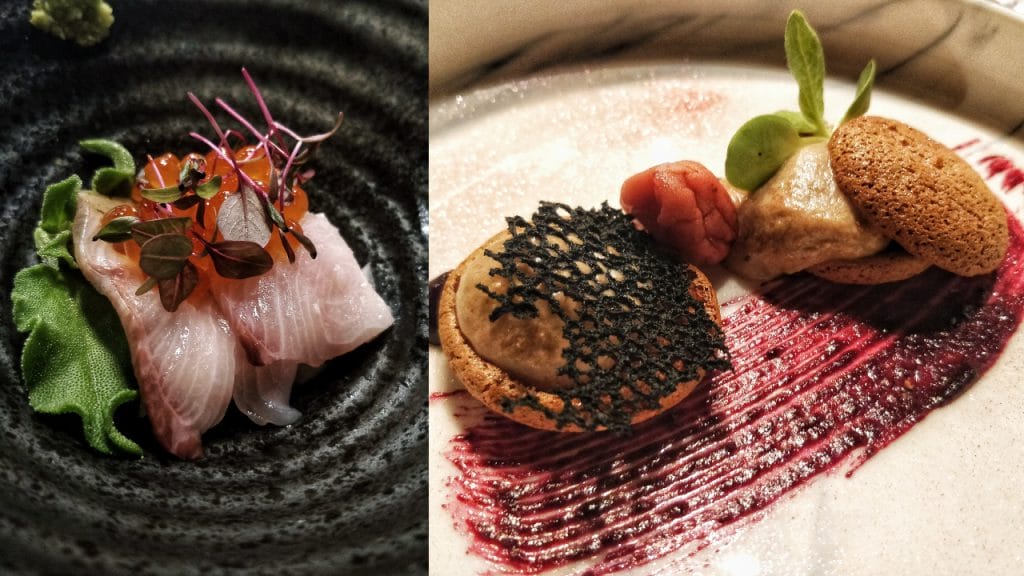How wonderful is the place that chimes with its name. At Gesuto, you feel welcome in a way that eludes words. Gesuto means ‘guest’ in Japanese, and the restaurant’s genuine, gracious, service sustains you in our time of pandemic.
This robatayaki exponent opened its doors pre-pandemic and pulled off its first formal wine dinner after a nine-month gestation. Robatayaki is a traditional cooking method using extreme heat that requires great skill and precision, and Gesuto chose to complement its cuisine with the suitably impeccable wines of Moulin de Gassac.

There is a level of care that shows in the aliveness and refinement of the food and wine; both are redolent of the freshness of artisanal sake made with spring water, or somehow allude to it. It’s not something you can rate easily on a scale of 100 points based on individual criteria of colour, nose, body, etc; it’s a quality of subtlety. But you know it body and soul: a divine coherence of all its parts, a precious integrity that speaks to you and all your senses in a single moment.
View this post on Instagram
Despite, or perhaps because of all this, Gesuto does not consider itself a “high-end” establishment. It says it offers “‘not so serious’ Japanese dining that combines traditional Japanese techniques and cuisine with contemporary and international flavours with each dish.”

Serious or not, the Gesuto team is modest to a fault, preferring not to take the celebrity chef route even though it has the collective experience and talent to burn. Among its members is a well-seasoned and travelled certified master chef, and another who has worked the kitchens of Michelin-starred restaurants, being accomplished in confiserie, patisserie and bakery.
Since we mention “burn”, we’ll take a quick dive into fiery robatayaki’s creation myth. The fisherfolk of Hokkaido in northernmost Japan had wanted a way to cook their fresh catch at the end of long days at sea. But in the fading light of the setting sun, it was hard to start a fire. In short, they needed a portable oven in which to slow-cook their bounty so it would be perfectly done when they reached shore, just in time for sharing.
Solution: charcoal in a fireproof box. It sounds simple in hindsight, but try doing this without lithium batteries, cloud services and syncing across all your devices. Not that they needed such techiness: traditional cultures aren’t popularly associated with scientific precision, but the fisherfolk had put theoretical physics into practice by using their direct experience of working with nature. (The earth provides for all our needs; in fact, everything in existence.)

The special wood charcoal that is still used in robatayaki cooking is called bincho. It’s made by artisans, and burns hot enough to melt metal; so hot it doesn’t smoke or catch fire but glows. Skilled chefs use robatayaki to sear food to create a crisp outer layer that naturally seals its juices and flavours within. Because bincho has only one “heat setting”, robatayaki demands a chef who can manipulate space and time, cooking different foods at an optimal distance for just so long.
The results can bowl you over. Try ordering something basic, such as sweet potato, and revel in the unexpected result of clean yet complex and luxurious flavours that match up with wine.
A word about Moulin de Gassac: winos will be familiar with Mas de Daumas Gassac, from which the former draws its lineage. Both estates have been owned and run by the Guibert family for five decades and are in the Languedoc. If Paris in the North is the Death Star, then d’Oc in the South is the Rebel Alliance with a fine heritage of resistance that goes back to Roman times. Its extraordinary spiritual traditions are largely erased from popular memory but one wonders what lives on in its wines.
Gesuto
Robata tasting menu

Amuse bouche
Ika logout, edamame fritter, beetroot foam
NV Domaine Delmas Séduction Cuvée, Crémant de Limoux
Tasmanian hiramasa
Kingfish sashimi, smoked ikura, shish-soya emulsion
2018 Moulin de Gassac, Sauvignon Blanc, IGP Pays d’Oc
Kuro suguri makaron
Blackcurrant meringue, foie gras mousse, une plum marmalade
2018 Moulin de Gassac, Guilhem Rosé, IGP Pays d’Hérault
Hotate-no truffle gyoza
Scallop truffle dumplings, beurre blanc
2018 Moulin de Gassac, Merlot, IGP Pays d’Oc
Kenchin jiru
Palate-cleansing broth; shiitake, ginseng
Ko-hitsuji Yaki no gochujang
Lamb rack, red Korean child spice, eggplant confit
2016 Moulin de Gassac, Terra, AOP Languedoc
Gesuto dezato moriawase
Selection of artisan petit fours
Gesuto offers a different tasting menu every month; its current four-course Christmas selection is priced at RM168+ per person while the five-course Cristmas selection is priced at RM208+ per person.




